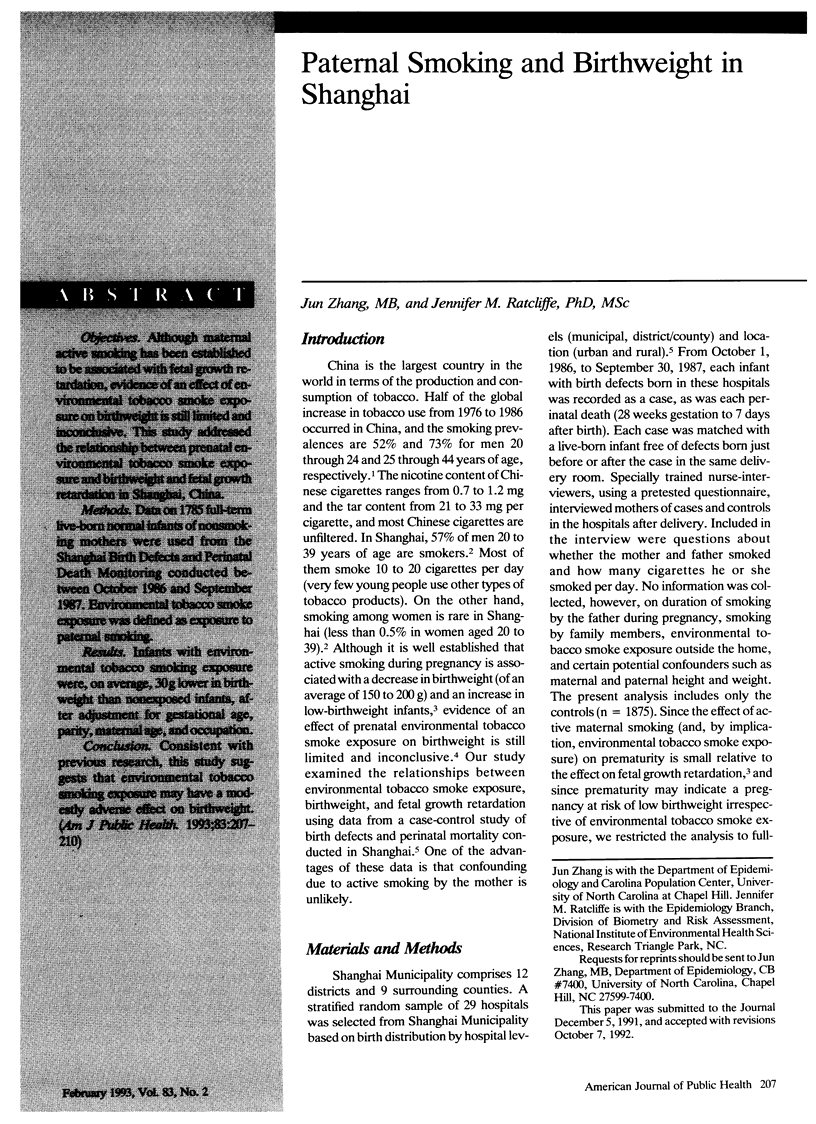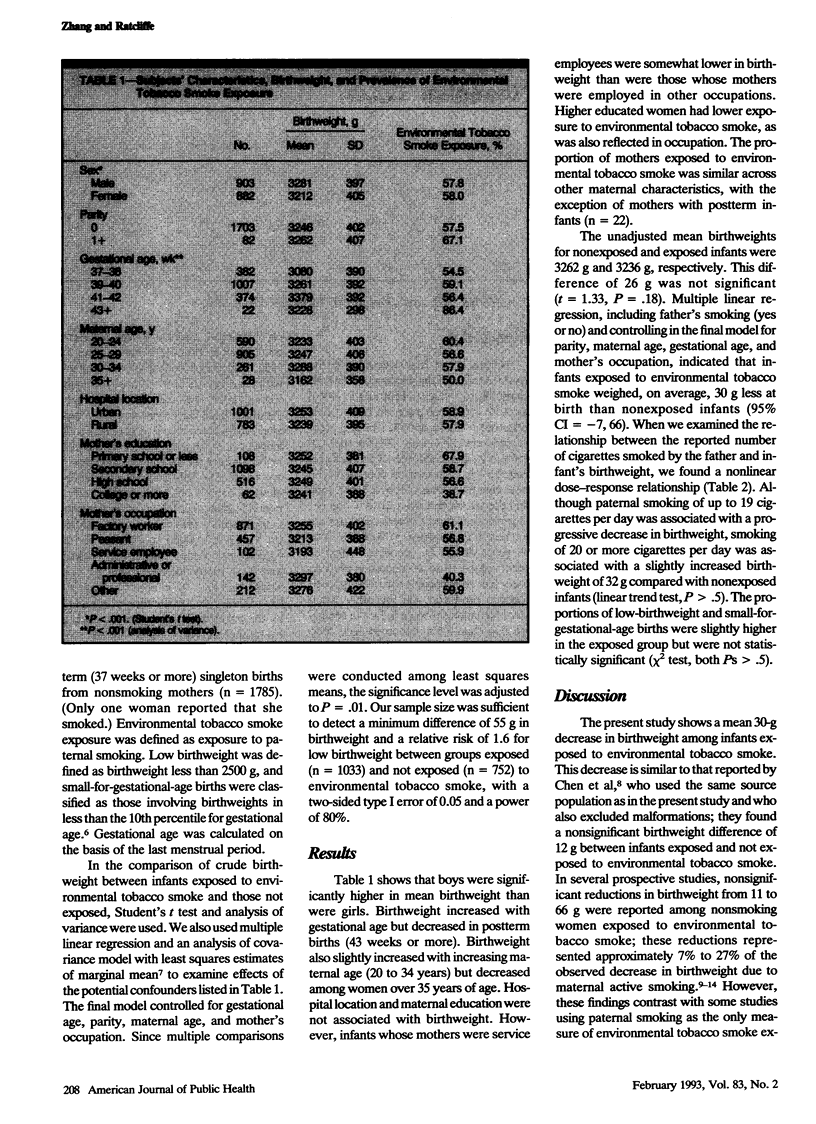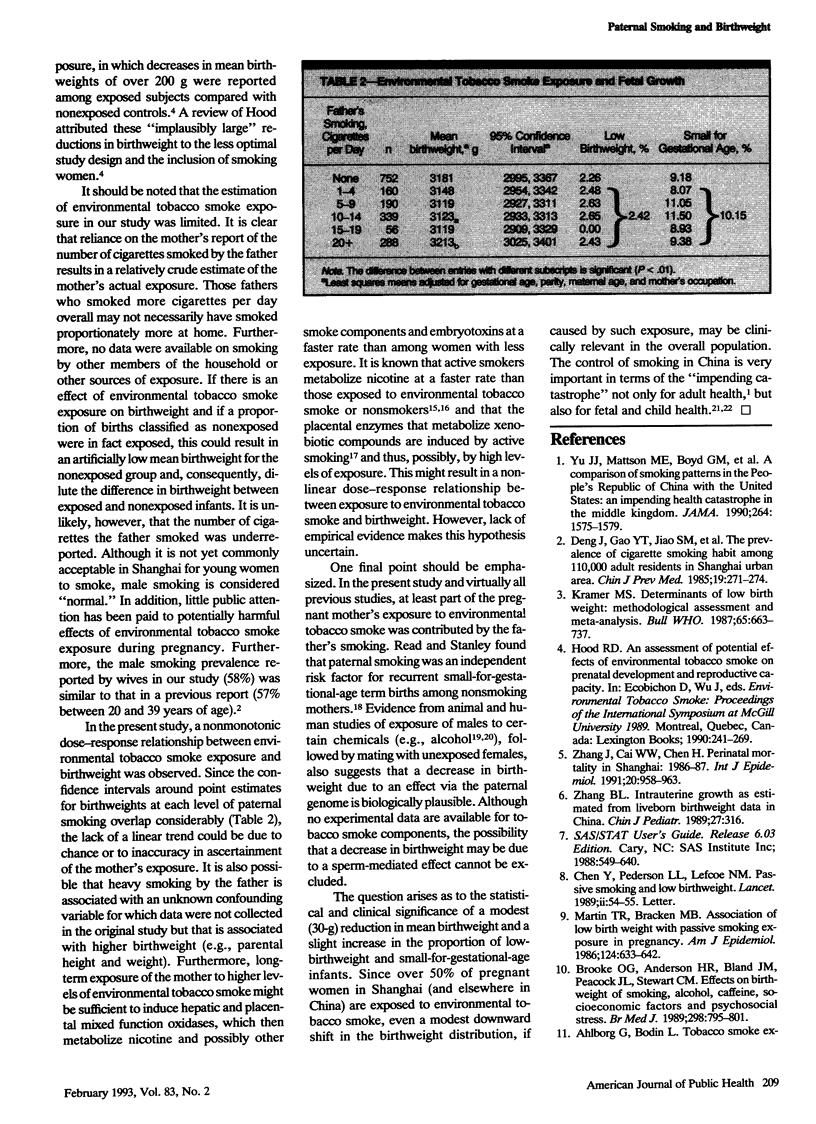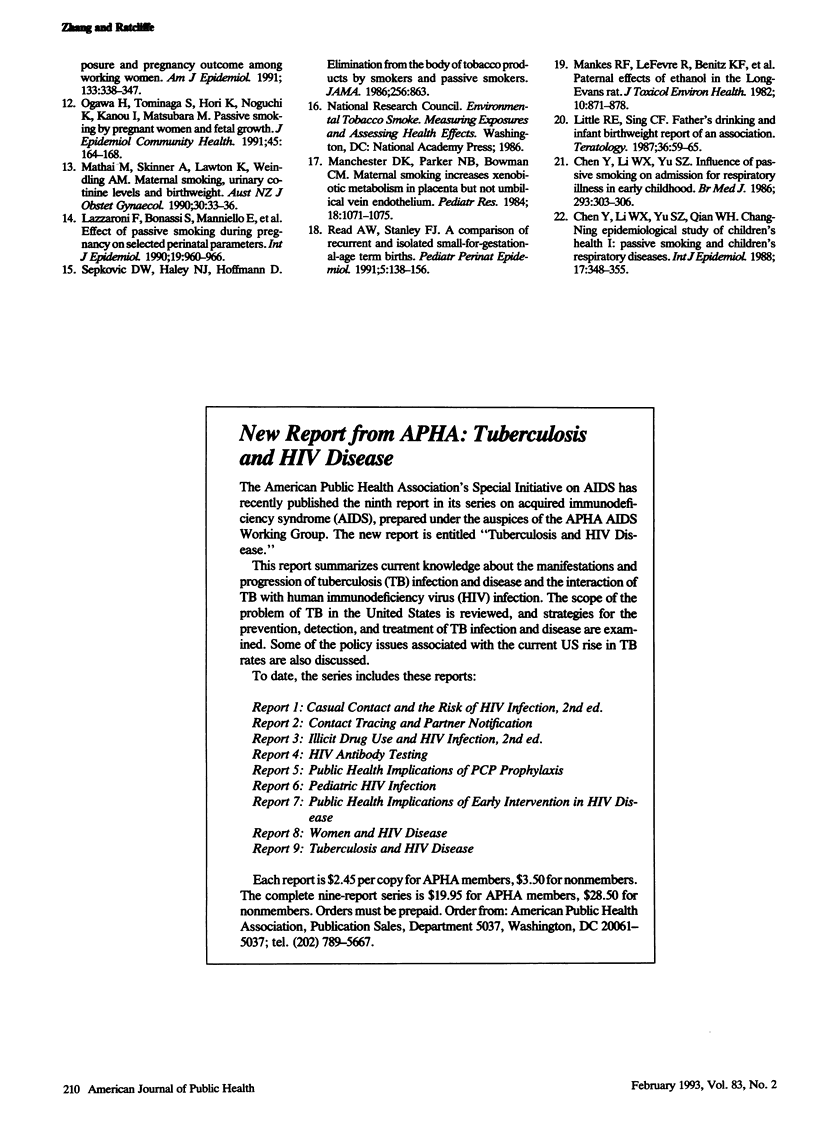Abstract
OBJECTIVES. Although maternal active smoking has been established to be associated with fetal growth retardation, evidence of an effect of environmental tobacco smoke exposure on birthweight is still limited and inconclusive. This study addressed the relationship between prenatal environmental tobacco smoke exposure and birthweight and fetal growth retardation in Shanghai, China. METHODS. Data on 1785 full-term live-born normal infants of nonsmoking mothers were used from the Shanghai Birth Defects and Perinatal Death Monitoring conducted between October 1986 and September 1987. Environmental tobacco smoke exposure was defined as exposure to paternal smoking. RESULTS. Infants with environmental tobacco smoking exposure were, on average, 30 g lower in birthweight than nonexposed infants, after adjustment for gestational age, parity, maternal age, and occupation. CONCLUSION. Consistent with previous research, this study suggests that environmental tobacco smoking exposure may have a modestly adverse effect on birthweight.
Full text
PDF



Selected References
These references are in PubMed. This may not be the complete list of references from this article.
- Ahlborg G., Jr, Bodin L. Tobacco smoke exposure and pregnancy outcome among working women. A prospective study at prenatal care centers in Orebro County, Sweden. Am J Epidemiol. 1991 Feb 15;133(4):338–347. doi: 10.1093/oxfordjournals.aje.a115886. [DOI] [PubMed] [Google Scholar]
- Brooke O. G., Anderson H. R., Bland J. M., Peacock J. L., Stewart C. M. Effects on birth weight of smoking, alcohol, caffeine, socioeconomic factors, and psychosocial stress. BMJ. 1989 Mar 25;298(6676):795–801. doi: 10.1136/bmj.298.6676.795. [DOI] [PMC free article] [PubMed] [Google Scholar]
- Chen Y., Li W. X., Yu S. Z., Qian W. H. Chang-Ning epidemiological study of children's health: I: Passive smoking and children's respiratory diseases. Int J Epidemiol. 1988 Jun;17(2):348–355. doi: 10.1093/ije/17.2.348. [DOI] [PubMed] [Google Scholar]
- Chen Y., Li W., Yu S. Influence of passive smoking on admissions for respiratory illness in early childhood. Br Med J (Clin Res Ed) 1986 Aug 2;293(6542):303–306. doi: 10.1136/bmj.293.6542.303. [DOI] [PMC free article] [PubMed] [Google Scholar]
- Chen Y., Pederson L. L., Lefcoe N. M. Passive smoking and low birthweight. Lancet. 1989 Jul 1;2(8653):54–55. doi: 10.1016/s0140-6736(89)90304-8. [DOI] [PubMed] [Google Scholar]
- Deng J. [The prevalence of the cigarette smoking habit among 110,000 adult residents in the Shanghai urban area]. Zhonghua Yu Fang Yi Xue Za Zhi. 1985 Sep;19(5):271–274. [PubMed] [Google Scholar]
- Kramer M. S. Determinants of low birth weight: methodological assessment and meta-analysis. Bull World Health Organ. 1987;65(5):663–737. [PMC free article] [PubMed] [Google Scholar]
- Lazzaroni F., Bonassi S., Manniello E., Morcaldi L., Repetto E., Ruocco A., Calvi A., Cotellessa G. Effect of passive smoking during pregnancy on selected perinatal parameters. Int J Epidemiol. 1990 Dec;19(4):960–966. doi: 10.1093/ije/19.4.960. [DOI] [PubMed] [Google Scholar]
- Little R. E., Sing C. F. Father's drinking and infant birth weight: report of an association. Teratology. 1987 Aug;36(1):59–65. doi: 10.1002/tera.1420360109. [DOI] [PubMed] [Google Scholar]
- Manchester D. K., Parker N. B., Bowman C. M. Maternal smoking increases xenobiotic metabolism in placenta but not umbilical vein endothelium. Pediatr Res. 1984 Nov;18(11):1071–1075. doi: 10.1203/00006450-198411000-00002. [DOI] [PubMed] [Google Scholar]
- Mankes R. F., LeFevre R., Benitz K. F., Rosenblum I., Bates H., Walker A. I., Abraham R., Rockwood W. Paternal effects of ethanol in the long-evans rat. J Toxicol Environ Health. 1982 Dec;10(6):871–878. doi: 10.1080/15287398209530302. [DOI] [PubMed] [Google Scholar]
- Martin T. R., Bracken M. B. Association of low birth weight with passive smoke exposure in pregnancy. Am J Epidemiol. 1986 Oct;124(4):633–642. doi: 10.1093/oxfordjournals.aje.a114436. [DOI] [PubMed] [Google Scholar]
- Mathai M., Skinner A., Lawton K., Weindling A. M. Maternal smoking, urinary cotinine levels and birth-weight. Aust N Z J Obstet Gynaecol. 1990 Feb;30(1):33–36. doi: 10.1111/j.1479-828x.1990.tb03192.x. [DOI] [PubMed] [Google Scholar]
- Ogawa H., Tominaga S., Hori K., Noguchi K., Kanou I., Matsubara M. Passive smoking by pregnant women and fetal growth. J Epidemiol Community Health. 1991 Jun;45(2):164–168. doi: 10.1136/jech.45.2.164. [DOI] [PMC free article] [PubMed] [Google Scholar]
- Read A. W., Stanley F. J. A comparison of recurrent and isolated small-for-gestational-age term births. Paediatr Perinat Epidemiol. 1991 Apr;5(2):138–156. doi: 10.1111/j.1365-3016.1991.tb00695.x. [DOI] [PubMed] [Google Scholar]
- Sepkovic D. W., Haley N. J., Hoffmann D. Elimination from the body of tobacco products by smokers and passive smokers. JAMA. 1986 Aug 15;256(7):863–863. [PubMed] [Google Scholar]
- Yu J. J., Mattson M. E., Boyd G. M., Mueller M. D., Shopland D. R., Pechacek T. F., Cullen J. W. A comparison of smoking patterns in the People's Republic of China with the United States. An impending health catastrophe in the middle kingdom. JAMA. 1990 Sep 26;264(12):1575–1579. [PubMed] [Google Scholar]
- Zhang J., Cai W. W., Chen H. Perinatal mortality in Shanghai: 1986-1987. Int J Epidemiol. 1991 Dec;20(4):958–963. doi: 10.1093/ije/20.4.958. [DOI] [PubMed] [Google Scholar]


